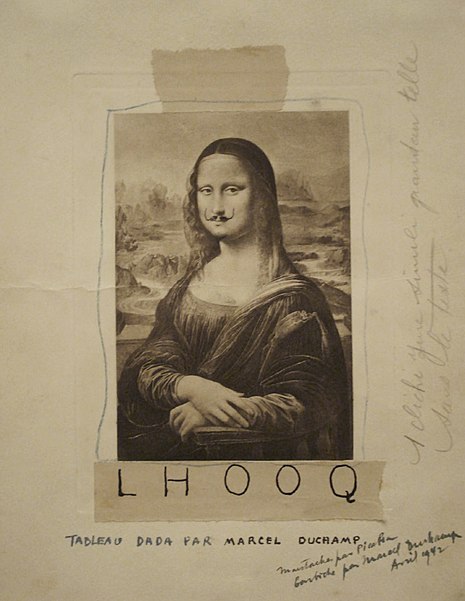- Last 7 days
-
en.wikipedia.org en.wikipedia.org
- Apr 2022
-
Local file Local file
-
As for Duchamp, his early interest in Roussel was probably revived by the stunningdisclosure that most of his narratives, and among them the cult novel Impressionsd’Afrique (1910), had been generated from puns reminiscent of LHOOQ.
L.H.O.O.Q. is a Marcel Duchamp readymade artwork conceived in 1919. The work consists of a cheap postcard reproduction of Da Vinci's Mona Lisa (the found object or objet trouvé), "improved" by Duchamp with the addition of a penciled in moustache and a goatee with the title drawn in large capital letters underneath.

L.H.O.O.Q. is a pun whose letters pronounced one at a time in French sound like "Elle a chaud au cul". This translates variously as "She is hot in the arse" or "She has a hot ass". "Avoir chaud au cul" is a vulgar expression implying that a woman has sexual restlessness. Duchamp, in an interview, gave a loose translation of L.H.O.O.Q. as "there is fire down below". (Schwarz 203)
link: https://hyp.is/GPVO4sA6EeyYiZdqyfGJSA/en.wikipedia.org/wiki/L.H.O.O.Q.
-
- May 2017
-
static1.squarespace.com static1.squarespace.com
-
two plant·onic moments
Yo, everybody needs to check out this pun and feel their soul die so I'm not alone in this.
-
- Mar 2017
-
static1.squarespace.com static1.squarespace.com
-
we can see how readily realism leads into symbolism. For the succession of scenes both re-alistically reflects the course of the action and symbolizes it
I'm quite fond of this line. First, it addresses the usual rejection of the symbolic in fiction that you get from people about books and movies, but second, it really gets to blurring divides, in fiction and reality, that I see a lot of with Burke's later takes on literature/poetics and rhetoric.
It also includes a pun that makes this unnecessarily confusing, which is just so apt.
-
- Jan 2016
-
l2ork.music.vt.edu l2ork.music.vt.edu
-
It was not so very long ago that people thought that semiconductors were part-time orchestra leaders and microchips were very, very small snack foods. --Geraldine A. Ferraro
Good one.
-